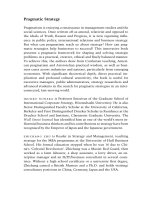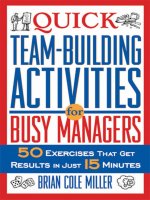Team building and communication styles employee relations 1
Bạn đang xem bản rút gọn của tài liệu. Xem và tải ngay bản đầy đủ của tài liệu tại đây (851.86 KB, 23 trang )
Thursday
Team-Building &
Communication Styles
Employee Relations II
BUS 208 Employee Relation
s
Spring 2006
“Get
ready for a wild ride…”
One person can’t
do it all in
today’s complex
workplace.
That’s why
employers want
and need people
who can work in
teams.
Working Together and Good
Communication
When working together the biggest
problems are caused by ineffective
or poor communication. Focusing
on positive communication is a key
to good employee relations. For
the manager this means
understanding the elements of:
I.
Intercultural Communication
II. Non-Verbal Communication
III. Listening Skills
IV. Communication Styles
Understanding Culture
Culture is a shared system of
symbols
beliefs
attitudes
values
expectations
behaviors
Understanding Subcultures
• Subcultures are cultural groups that
exist within a major culture
• An individual belongs to many
subcultures
– Ethnic
– Religious
– Social
– Professional
Cultural Differences Can Have an
Impact on Communication
•
•
•
•
•
•
•
•
Social values and customs
Roles and status
Decision-making customs
Concepts of time and personal
space
Cultural context
Body language
Social behavior and manners
Legal and ethical behavior
Cultural Context
High Context:
Low Context:
- When people rely less
on verbal
communication and
more on nonverbal
and environmental
cues…
- When people rely
heavily on verbal
communication rather
than nonverbal
communication or
environmental cues...
Practicing Good Intercultural
Communication Skills
Withhold judgment
Show respect
Empathize
Tolerate ambiguity
Recognize your own cultural
biases
Emphasize common ground
Send clear messages
Learn when to be direct
Intercultural Communication
Challenges
• Language
barriers
– Vocabulary and
pronunciation
– Inflection or
volume
– Idiomatic
expressions
– Body language
• Ethnocentric
reactions
– Judging according to
one’s standards
– Ignoring cultural
distinctions
– Assuming others
react as you do
– Stereotyping
Non-Verbal Communication
“Actions Speak
Louder than
Words”
But the meaning of
nonverbal
communication lies
with the observer…
Six Varieties of Nonverbal
Behavior
Facial expressions and eye behavior
Gestures and postures
Vocal characteristics
Personal appearance
Touching behavior
Use of time and space
How to Improve Your Non-Verbal
Skills
Smile genuinely
Be aware of false nonverbal clues
Keep appropriate
distance
Respect status with your
eyes
Adopt a handshake that
matches you
The Art of Listening
Listening is a skill that everyone
should improve.
Listening can separate the okay
managers and employees from the
great ones.
It makes a huge difference in
understanding the needs of our
customers - internal and external.
It is a good habit that can be
exercised and improved.
Listening in Management Skills
• Use Active Listening Skills
• Understand the difference between
facts & feelings
• Speak congruently with your body
language
• Show signals that you are listening
• Mirror - Show that you understand
feelings, a method to let people know
you care
• Paraphrase, but don’t be a parrot.
Are You A Good Listener?
• When are you the best
at listening?
• How do you
compensate for your
weaknesses?
• What are your barriers
to good listening?
How to Improve Listening
•
•
•
•
•
•
•
•
Use nonverbal communication
Be audience-centered
Listen for and review key points
Remain objective
Anticipate
Limit note taking
Evaluate content, not speaker
Paraphrase and provide feedback
Working in Groups
Four Phases of Group DecisionMaking
1. Orientation
2. Conflict
3. Emergence
4. Reinforcement
Role of Meeting Leader
• Encourages participation
• Arranges recording and
distribution of minutes
• Keeps participants focused
• Balances participants’ input
• Summarizes progress
Steps in Planning a Meeting
• Decide on purpose
• Select participants, time,
location
• Prepare agenda
– Use informative phrasing
– Distribute in advance
– Answer key questions
Holding Effective Meetings
Ask “Why” are we here.
Make sure the purpose of
the meeting is clearly
defined.
Start on Time.
Set the Ground Rules.
Use the “future file” or
“parking lot”
Keep to the Agenda
Wrap it up and summarize
at the end!
Resolving Conflict
• Possible outcome • Win-Win assumptions
– Win-Lose
– Lose-Lose
– Win-Win
– Mutual satisfaction
possible
– Parties willing to
cooperate
– Parties can be trusted
– No pulling rank
How to Overcome
Resistance
Express understanding
Remain calm
Respect cultural differences
Create awareness of
resistance
Be objective
Encourage candor









